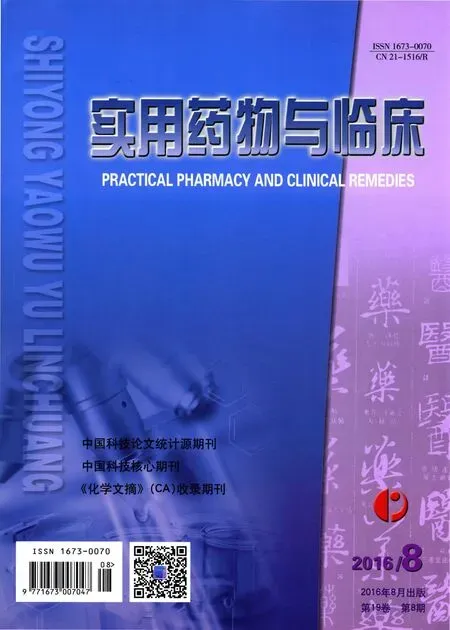腰-硬联合麻醉加入微量右美托咪定用于择期剖宫产手术的麻醉效果分析
张茂鹏,刘 伟,刘浩东
腰-硬联合麻醉加入微量右美托咪定用于择期剖宫产手术的麻醉效果分析
张茂鹏,刘伟,刘浩东
目的探讨腰-硬联合麻醉加入微量右美托咪定用于择期剖宫产手术的临床效果。方法选取2014年6月至2015年11月于我院拟行择期剖宫产手术产妇104例,随机分为2组,每组52例。观察组患者接受腰-硬联合麻醉时硬膜外注入10 mL 0.25%布比卡因、1 mL 0.5 μg/kg右美托咪定和50 μg芬太尼的混合物,对照组以1 mL 0.9% NaCl代替右美托咪定。比较两组产妇补充芬太尼的剂量差异,记录产妇术后24 h的不良反应,如低血压、心动过缓、恶心、呕吐及瘙痒等。结果观察组产妇术中、术后使用芬太尼的构成比低于对照组(7.7% vs.25.0%,11.5% vs.38.5%),平均用量少于对照组[(12.5±3.1) μg vs.(6.3±10.7) μg],差异均有统计学意义(P<0.05)。两组患者的主要不良反应有低血压、心动过缓及恶心、呕吐,且两组不良反应发生率比较差异无统计学意义(P>0.05)。结论腰-硬联合麻醉加入微量右美托咪定可明显提高剖宫产的术中操作条件及术后镇痛效果。
腰-硬联合麻醉;右美托咪定;芬太尼;剖宫产
0 引言
椎管内麻醉分为硬膜外麻醉(Epidural anesthesia)和脊髓麻醉(Spinal anesthesia),与全身麻醉相比,前者允许产妇保持清醒,可大大降低误吸、插管失败风险及孕妇死亡率,是目前择期剖宫产手术使用最为广泛的麻醉方式[1-3]。右美托咪定是高选择性的α2肾上腺素受体激动剂,可使患者处于镇静但可唤醒的状态,降低患者的交感神经张力,提供良好的可合作的镇静状态[4-6]。本研究旨在评估腰-硬联合麻醉加入微量右美托咪定对择期剖宫产术中和术后麻醉质量的影响,现报道如下。
1 资料与方法
1.1一般资料纳入标准:年龄18~40岁、ASAⅠ或Ⅱ级且分娩过程要求保持清醒。排除妊娠高血压、肝肾疾病、胎盘前置、胎盘增生、重度肥胖(BMI>38 kg/m2)、术前6 h接受阿片样受体激动剂或拮抗剂及有椎管内麻醉禁忌证的产妇。选取2014年6月至2015年11月于我院拟行择期剖宫产手术的产妇104例。所有产妇均自愿参加本研究并签署知情同意书,且经过我院伦理委员会批准此次临床试验。
1.2试验方法将104例产妇按照随机数字生成表法随机分为2组,每组52例。产妇取坐姿,采用针过针技术在L2-3间隙利用中线方法进行腰-硬联合麻醉。18 G Tuohy针用于定位硬膜外腔隙,27 G笔尖式腰穿针用于硬膜穿刺。确保脑脊液完全吸出后,1 mL 0.5% 5 mg高比重布比卡因鞘内注射。撤除腰穿针,通过硬膜外针注入12 mL研究溶液。研究溶液为10 mL 0.25%布比卡因、1 mL 0.5 μg/kg右美托咪定[7]和1 mL 50 μg芬太尼混合物(观察组),或者10 mL 0.25%布比卡因、1 mL 0.9% NaCl和1 mL 50 μg芬太尼混合物(对照组)。记录产妇感觉阻滞最高水平(Smax)和Smax达标所需时间。
感觉阻滞在双侧锁骨中线利用针刺试验完成,前5 min每分钟1次,其后每5分钟1次。下肢运动阻滞程度由改良Bromage分级法[8]评估:BS0为无运动神经阻滞;BS1为不能抬腿;BS2为不能弯曲膝部;BS3为不能弯曲踝关节(完全运动阻滞)。记录鞘内注射至准备手术时间、皮肤切口至分娩时间及子宫切口至分娩时间。利用10 cm视觉模拟评分法(VAS)[9]评估产妇的疼痛水平:0表示无痛感,10表示极痛。出现低血压(血压较试验前降低20%或收缩压<100 mmHg)时立即静脉注射5 mg麻黄素;出现心动过缓(心率<50次/min)时立即静脉注射0.5 mg阿托品;术后疼痛开始时间为手术完成至VAS>4开始时间;运动阻滞恢复时间为硬膜外溶液注射至恢复到BS0所需时间。镇静水平利用5点数值镇静量表法评估:0级为完全清醒;1级为平静;2级为对口头命令清醒;3级为对温柔触觉刺激清醒;4级为对剧烈触觉刺激清醒;5级为无法清醒。肌肉松弛水平分为差、一般、良、优。术后所有产妇每隔6小时静脉给予15 mg/kg对乙酰氨基酚。对于VAS评分>4的过度疼痛产妇,静脉补加50 μg芬太尼急救。
1.3观察指标比较两组产妇补加芬太尼的剂量差异,记录产妇术后24 h的不良反应,如低血压、心动过缓、恶心、呕吐及瘙痒等。

2 结果
2.1两组产妇的基线特征及阻滞特征情况两组产妇的年龄、体重、剖宫产史、阻滞时间及肌肉松弛水平比较差异无统计学意义(P>0.05),具有可比性。见表1~表3。

表1 两组产妇的基线资料比较(例,%)

表2 两组阻滞时间比较(min)

表3 两组肌肉松弛水平比较(例,%)
2.2两组产妇芬太尼补充使用及术中镇静水平情况的分析两组产妇术中、术后补充使用芬太尼的例数及平均用量比较差异均有统计学意义(P<0.05)。两组大部分产妇处于术中镇静1级水平,且两组术中镇静评分比较差异无统计学意义(P>0.05)。见表4、表5。
2.3两组产妇不良反应及新生儿Apgar评分情况两组的主要不良反应有低血压、心动过缓及恶心、呕吐,且两组不良反应发生率比较差异无统计学意义(P>0.05)。两组新生儿的Apgar评分均处于正常范围内。观察组胎儿出生后1、5 min时的Apgar评分略高于对照组,差异无统计学意义(P>0.05)。见表6。
3 讨论
麻醉是剖宫产手术中一个非常关键的环节。然而,常规单纯硬膜外麻醉用于剖宫产手术,尤其对于较大婴儿的分娩,存在一定弊端,如麻醉效果延迟产生、骶神经根阻滞很难实现及肌松作用不充分等[10]。腰-硬联合麻醉方法可避免上述缺点。有报道,局麻药联合辅助药物可提高剖宫产术中和术后的麻醉质量,帮助产妇运动阻滞的早期恢复及降低相关不良反应的发生[11]。其中,辅助药物多指阿片类药物(芬太尼)和α2肾上腺素能激动剂(右美托咪定)。

表4 两组产妇补充使用芬太尼情况比较(例,%)

表5 两组术中镇静水平情况比较(例,%)

表6 两组产妇的不良反应及新生儿Apgar评分情况(例,%)
尽管硬膜外给予芬太尼的不良反应,如呼吸抑制、尿潴留和恶心、呕吐发生率较低,但因其麻醉作用快速且维持时间较短,患者常需行病人自控硬膜外麻醉。故该麻醉方法不适合部分患者,如经济条件较低或教育水平较低不愿合作者[12]。因此,急需寻求一种可替代芬太尼的药物或可联合芬太尼使用的α2肾上腺素能激动剂。
阿片类药物与α2肾上腺素能激动剂的镇痛作用机制不同,二者联合可产生协同作用,且不增加阿片类药物的相关不良反应。
已有研究显示,注射位点周围血管收缩可延迟局麻药的吸收,延长麻醉持续时间[13]。Konacki等[14]发现,5 μg/kg右美托咪定具有潜在的神经毒性作用,表现为少突胶质细胞的脱髓鞘作用。而本研究中右美托咪定的使用剂量为0.5 μg/kg,临床试验已证实该有效剂量不会引起不良反应[7]。多项临床试验表明,右美托咪定的硬膜外剂量范围为1~2 μg/kg,高剂量可提高局麻效果,改善术中和术后镇痛作用[15-16]。但高剂量的使用也常常引起不良反应,如运动阻滞延迟、心动过缓及低血压等。右美托咪定脂溶性高,容易保留在胎盘组织中,少量可转移至胎儿体内,因此对胎儿的生长也产生不利作用。Jain等[17]研究表明,右美托咪定可延长镇痛作用,减少下肢骨科手术患者急救镇痛药的用量。
本研究中,观察组产妇术中、术后补充使用芬太尼的例数及平均用量均少于对照组,表明加入右美托咪定使得腰-硬联合麻醉的镇痛效果更显著。两组患者的主要不良反应有低血压、心动过缓及恶心、呕吐,且组间差异无统计学意义,表明加入右美托咪定并未提高腰-硬联合麻醉的不良反应发生率。有研究显示,应用2 μg/kg右美托咪定后,患者的动脉血压和心率明显降低[15-16]。而本研究0.5 μg/kg剂量使得患者的血流动力学特征始终保持稳定。
综上所述,腰-硬联合麻醉加入微量右美托咪定可明显改善剖宫产术中的操作条件及术后的镇痛效果。
[1]Alkaya Solmaz F,Cuhruk H.The application of epidural anesthes1a in pregnant woman with uncorrected tetralogy of Fallot:a case report[J].Agri,2015,27(4):215-218.
[2]Agarwal P,Pierce J,Welch WC.Cost analysis of spinal versus general anesthesia for lumbar discectomy and laminectomy spine surgery[J].World Neurosurg,2016,89:266-271.
[4]Bellon M,Le Bot A,Michelet D,et al.Efficacy of intraoperative dexmedetomidine compared with placebo for postoperative pain management:a meta-analysis of published studies[J].Pain Ther,2016,5(1):63-80.
[5]Majumdar M,Wilks B,Charlesworth D.Safe and efficacious use of dexmedetomidine over a prolonged duration for anxiolysis and as an adjunct to analgesia during end-of-life care[J].J Palliat Care,2015,31(4):265-267.
[6]Zhang N,Cai YR,Yi XW,et al.Effects of prolonged anesthesia with dexmedetomidine,fentanyl,or remifentanil on the self-renewal of mouse embryonic stem cells[J].Genet Mol Res,2015,14(4):17809-17819.
[7]Zeng XZ,Xu YM,Cui XG,et al.Low-dose epidural dexmedetomidine improves thoracic epidural anaesthesia for nephrectomy[J].Anaesth Intensive Care,2014,42(2):185-190.
[8]Graham AC,McClure JH.Quantitative assessment of motor block in labouring women receiving epidural analgesia[J].Anaesthesia,2001,56(5):470-476.
[9]Akram M,Farooqi FM,Irshad M,et al.Role of addition of Dexamethasone and Ketorolac to lignocaine intravenous regional anesthesia (Bier′s Block) to improve tourniquet tolerance and post-operative analgesia in hand and forearm surgery[J].J Pak Med Assoc,2015,65 (Suppl 3)(11):S128-S131.
[10]Moucha CS,Weiser MC,Levin EJ.Current Strategies in Anesthesia and Analgesia for Total Knee Arthroplasty[J].J Am Acad Orthop Surg,2016,24(2):60-73.
[11]Wallet F,Clement HJ,Bouret C,et al.Effects of a continuous low-dose clonidine epidural regimen on pain,satisfaction and adverse events during labour:a randomized,double-blind,placebo-controlled trial[J].Eur J Anaesthesiol,2010,27:441-447.
[12]Gessler F,Mutlak H,Tizi K,et al.Postoperative patient-controlled epidural analgesia in patients with spondylodiscitis and posterior spinal fusion surgery[J].J Neurosurg Spine,2016,5:1-6.
[13]Yoshitomi T,Kohijitani A,Maeda S,et al.Dexmedetomidine enhances the local anesthetic action of lidocaine via an α-2A adrenoceptor[J].Anesth Analg,2008,107(96):101.
[14]Konakci S,Adanir T,Yilmaz G,et al.The efficacy and neurotoxicity of dexmedetomidine administered via the epidural route[J].Eur J Anaesthesiol,2008,25:403-409.
[15]Bajwa SJS,Bajwa SK,Kaur J,et al.Dexmedetomidine and clonidine in epidural anaesthesia:a comparative evaluation[J].Indian J Anesth,2011,55(2):116-121.
[16]Elhakim M,Abdelhamid D,Abdelfattach H,et al.Effect of epidural dexmedetomidine on intraoperative awareness and post-operative pain after one-lung ventilation[J].Acta Anaesthesiol Scand,2010,54:703-709.
[17]Jain D,Khan RM,Kumar D,et al.Perioperative effect of epidural dexmedetomidine with intrathecal bupivacaine on haemodynamic parameters and quality of analgesia[J].South Afr J Anaesth Analg,2012,18(1):105-109.
Anesthetic effect of mini-dose dexmedetomidine added into combined spinal-epidural anesthesia for elective cesarean section
ZHANG Mao-peng1,LIU Wei,LIU Hao-dong
(Department of Anesthesiology,Women & Children′s Health Care Hospital of Baoji,Baoji 721000,China)
ObjectiveTo investigate the anesthetic effect of mini-dose dexmedetomidine added into combined spinal-epidural anesthesia for elective cesarean section.MethodsTotally 104 parturients undergoing elective cesarean section from June 2014 to November 2015 in our hospital were randomly divided into two groups.Parturients in observation group received combined spinal-epidural anesthesia with an epidural mixture of 10 mL 0.25% bupivacaine,1 mL 0.5 μg/kg dexmedetomidine and 50 μg fentanyl,while control group received 1 mL 0.9% NaCl instead of dexmedetomidine.The difference in dose of supplementary fentanyl was compared between the two groups,and the adverse effects,such as hypotension,bradycardia,nausea and vomiting and pruritus at 24 h after operation were recorded.ResultsThe rate of supplementary fentanyl use in observation group were less than that of control group during operation (7.7% vs.25.0%) and after operation (11.5% vs.38.5%),and the average amount of fentanyl in observation group was less:(12.5±3.1) μg vs.(6.3±10.7) μg,there were significant differences between the two groups (P<0.05).The main adverse effects included hypotension,bradycardia,nausea and vomiting,and no significant difference was observed between the two groups (P>0.05).ConclusionMini-dose epidural dexmedetomidine added into combined spinal-epidural anesthesia can obviously improve the intraoperative conditions and the quality of postoperative analgesia.
Combined spinal-epidural anesthesia;Dexmedetomidine;Fentanyl;Cesarean section
2016-02-23
宝鸡市妇幼保健院麻醉科,陕西 宝鸡 721000
10.14053/j.cnki.ppcr.201608013

